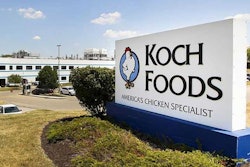
HKScan’s investment of about EUR6 million (US$7 million) in the new slaughter process of its poultry unit in Rauma, Finland, has been successfully implemented and put into operation.
The investment enables the unit to significantly improve its raw material yield, productivity and operational reliability. With the investment, the company responds to the strong growth in demand for responsibly produced Kariniemen poultry products.
The processing capacity of the unit’s slaughter line will increase with the investment by about 20 percent and raw material yield by about 10 percent. In addition, the investment will significantly reduce the consumption of utilities, such as water and district heating, the company stated. This is one step toward HKScan’s target of carbon-neutral food production in line with the company’s Zero Carbon climate plan.
“The new slaughter line was installed in stages during the early part of the year. The biggest changes were completed in recent weeks. Installation work proceeded as planned despite the additional challenges posed by the COVID-19 pandemic. Thanks to careful planning and our top professionals throughout the chain, the unit’s service level remained good during the installation work. After the equipment installations, we will continue to develop the unit’s productivity and striking power,” said Jari Leija, HKScan’s EVP Business Unit Finland.
Poultry products as one of HKScan’s growth drivers
“Poultry products play a key role in driving growth in line with HKScan’s strategy. HKScan is the second largest poultry company in its Baltic Sea region home markets. In 2020, our poultry product sales increased by over 12 percent and as a poultry product producer, we are the market leader in Finland, Estonia and Denmark. In Finland, we anticipate the demand for Kariniemen poultry products to continue strong also in the future,” said HKScan CEO Tero Hemmila.
HKScan said its Rauma unit delivers almost half of the poultry products in Finland. The unit’s service level and efficiency developed almost as planned in 2020, which improved the result of HKScan's poultry business in Finland. The target level has not yet been achieved. The investment now implemented enables the further development of the unit’s productivity and efficiency.
90% of energy used on Kariniemen farms already renewable
Kariniemen farms have been investing in responsibility for years as 90% of the energy used in the rearing halls is already renewable. On the Kiiski farm, animal welfare has been developed open-mindedly, for example, cameras were installed in the rearing areas to monitor the behavior and welfare of chickens. Cameras and artificial intelligence can be used to detect areas for improvement to further improve chicken welfare.
VTT has calculated the carbon footprint of ten Kariniemen pilot farms. The footprint is the smallest measured in Finland: an average of 2.4 kg CO2e per kilogram of animal live weight. Digital measurement methods of Kariniemen’s ecosystem partners help farmers to promote the carbon neutrality goal. In addition, HKScan is the first in the world to calculate the water footprint of Kariniemen’s poultry farm using the high-quality AWARE method. Kariniemen poultry products are a responsible choice also in terms of the water footprint.
Kariniemen chickens grow on HKScan’s contract farms in Satakunta and southwest Finland, and poultry meat used in Kariniemen products is 100% Finnish.

















